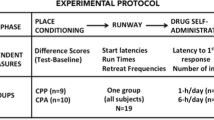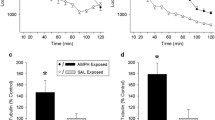Abstract
The relationship between the motor-activating and positive-reinforcing properties of d-amphetamine was examined in the place-preference paradigm. Two groups of animals were trained to associate one environment with amphetamine, and another environment with saline. Annimals that were allowed to locomote in both environments during training later demonstrated a preference for the amphetamine-paired environment; animals in which hyperactivity was limited in both environments later failed to show any preference. However, both groups of animals demonstrated a conditioned locomotor activation to the amphetamine-associated environments. Our results suggest that a place-preference demonstrated for an amphetamine-paired environment depends on the ability of the drug to increase locomotor behavior.
Similar content being viewed by others
References
Aulisi EF, Hoebel BG (1983) Rewarding effects of amphetamine and cocaine in the nucleus accumbens and block by flupenthixol. Soc Neurosci (Abstr) 9:121
Bozarth MA, Wise RA (1981) Heroin reward is dependent on a dopaminergic substrate. Life Sci 29:1881–1886
Carr GD, White NM (1983) Conditioned place preference from intra-accumbens but not intra-caudate amphetamine injections. Life Sci 33:2551–2557
Ettenberg A, van der Kooy D, Le Moal M, Koob GF, Bloom FE (1983) Can aversive properties of (peripherally-injected) vasopressin account for its putative role in memory? Behav Brain Res 7:331–350
Gilbert D, Cooper SJ (1983) P-Phenylethylamine, d-amphetamine- and l-amphetamine-induced place preference conditioning in rats. Eur J Pharmacol 95:311–314
Giovino AA, Glimcher PW, Mattel CA, Hoebel BG (1983) Phenycyclidine (PCP) generates conditioned reinforcement in the nucleus accumbens (ACC) but not in the ventral tegmental area (VTA). Soc Neurosci (Abstr) 9:120
Glimcher PW, Margol DH, Giovino AA, Hoebel BG (1984) Neurotensin: a new ‘reward peptide’. Brain Res 291:119–124
Joyce EM, Koob GF (1981) Amphetamine-, scopolamine- and caffeine-induced locomotor activity following 6-hydroxydopamine lesions of the mesolimbic dopamine systems. Psychopharmacology 73:311–313
Kalivas PW, Nemeroff CB, Prange AJ (1981) Increase in spontaneous motor activity following infusion of neurotensin into the ventral tegmental area. Brain Res 229:525–529
Kelley AE, Stinus L, Iversen SD (1980) Interaction between d-Ala-Met-enkephalin, A10 dopaminergic neurones, and spontaneous behaviour in the rat. Behav Brain Res 1:3–24
van der Kooy D, Swerdlow NR, Koob GF (1983) Paradoxical reinforcing properties of apomorphine: effects of nucleus accumbens and area postrema lesions. Brain Res 259:111–118
Kullback S (1968) Information theory and statistics. Dover: New York
Mucha RF, Volkovskis C, Kalant G (1981) Conditioned increases in locomotor activity produced with morphine as an unconditioned stimulus, and the relation of the conditioning to acute morphine effect and tolerance. J Comp Physiol Psychol 95:351–362
Mucha RF, van der Kooy D, O'Shaughnessy M, Bucenieks P (1982) Drug reinforcement studied by the use of place conditioning in rat. Brain Res 243:91–105
Pert A, Sivit C (1977) Neuroanatomical focus for morphine and enkephalin-induced hypermotility. Nature 265:645–647
Phillips AG, Lepiane FG (1982) Reward produced by microinjection of (d-Ala2), Met5-enkephalinamide into the ventral tegmental area. Behav Brain Res 5:225–229
Phillips AG, LePiane FG, Fibiger HC (1982) Dopaminergic mediation of reward produced by direct injection of enkephalin into the ventral tegmental area of the rat. Life Sci 33:2505–2511
Robbins TW (1977) A critique of the methods available for the measurement of spontaneous motor activity. In: Iversen L, Iversen S, Snyder S (eds) Handbook of psychopharmacology, vol 7. Plenum, New York, pp 37–82
Spyraki C, Fibiger HC, Phillips AG (1982a) Dopaminergic substrates of amphetamine-induced place preference conditioning. Brain Res 253:185–193
Spyraki C, Fibiger HC, Phillips AG (1982b) Cocaine-induced place preference conditioning: lack of effects of neuroleptics and 6-hydroxydopamine lesions. Brain Res 253:195–203
Swerdlow NR, Swanson LW, Koob GF (1983) Electrolytic lesions of the substantia innominata and lateral preoptic area abolish the ‘supersensitive’ locomotor response to apomorphine in rats resulting from denervation of the nucleus accumbens. Soc Neurosci (Abstr) 9:552
Tilson HA, Rech RH (1973) Conditioned drug effects and absence of tolerance to d-amphetamine induced motor activity. Pharmacol Biochem Behav 1:149–153
Author information
Authors and Affiliations
Rights and permissions
About this article
Cite this article
Swerdlow, N.R., Koob, G.F. Restrained rats learn amphetamine-conditioned locomotion, but not place preference. Psychopharmacology 84, 163–166 (1984). https://doi.org/10.1007/BF00427440
Received:
Accepted:
Issue Date:
DOI: https://doi.org/10.1007/BF00427440




